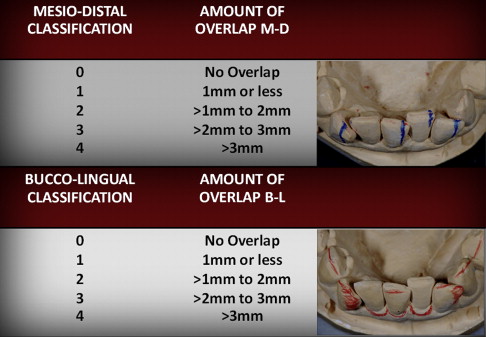Crowded dentition is commonly found in the esthetic zone. Many forms of therapy can be used to treat the overlap of teeth caused by insufficient space within the dental arch. A careful analysis of patients with dental crowding is necessary to determine the most appropriate treatment of each individual case. Clinical considerations, advantages, disadvantages, and alternative treatment modalities for crowding dentition are discussed in this article and a clinical case is presented to illustrate the application of these techniques.
Dental crowding can be simply defined as the overlap of teeth caused by insufficient space within the dental arch. This article addresses the apparent versus real correction of crowding within the esthetic zone. Crowding of anterior teeth usually has both a mesiodistal and buccolingual component. Drifting, aberrant eruption patterns, habits, tooth size discrepancies, space loss caused by early loss of deciduous teeth, and interproximal caries promoting migration are the typical contributing factors to the occurrence of crowding. Because the gingival alveolar complex conforms to the shape and position of the teeth, treatment planning for the correction of anterior crowding must include treatment considerations for the associated gingival discrepancies. As is the case for diastemata, in which excess intra-arch space exists, the treatment of anterior crowding presents the challenge of not only satisfying the patient’s desire to correct the esthetic deformity but also to provide the patient with a stable and functional result. This article considers the criteria for choosing a totally restorative, or so-called diamond (as in diamond bur) orthodontic, approach versus the need for a traditional orthodontic approach. Finding a conservative and biologically sound treatment plan in every clinical situation is the ideal goal. As is also true for diastemata, the participation of several dental disciplines is frequently required to accomplish the goal of esthetic correction of the crowded dentition. A clear understanding of the roles of the various disciplines in developing and executing the treatment plan is essential. Considerations include the variations and classification of dental crowding from the restorative perspective, the importance of orthodontic therapy, and why orthodontics may be appropriate in every treatment plan.
Classification of dental crowding
The degree of teeth misalignment directly influences the treatment options, and at times it can be difficult to define the difference between, mild, moderate, and severe levels of dental crowding. There are 2 components to consider in every case of crowding: the mesiodistal overlap and the buccolingual overlap. The amount of overlap can be measured in millimeters, classifying dental crowding according to its severity. Chu’s classification makes dental crowding variants less subjective and is therefore a valuable diagnostic tool in the process of treatment planning ( Fig. 1 ). In the ideal clinical situation, minor to moderate mesiodistal and buccolingual discrepancies can be corrected by restorative means. The management of severe discrepancies solely by restorative care is contraindicated by required tooth mutilation and possibly extensive support compromising periodontal surgery. The degree of vertical discrepancy is another component of crowding to be considered ( Fig. 2 ). Lack of proper centric stops may result in supraeruption of the teeth. The esthetically aberrant overerupted tooth, often with an aberrant alveolar gingival complex, is best treated with orthodontic intrusion. Supraeruption presents a restorative challenge because it can lead to overpreparation and the necessity for periodontal intervention. Any treatment modality for the crowded dentition should be designed to achieve form and function with minimal invasive dentistry. Esthetics, periodontal health and architecture, structural stability, and occlusion require equally careful attention. The patient’s long-term interests are best served by an approach that considers all these elements.





